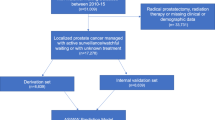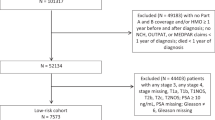Abstract
Background:
This study aimed to survey urologists regarding their knowledge, acceptance and practice of active surveillance (AS) for low-risk prostate cancer.
Methods:
An email-based survey was distributed to 4987 urologists. Respondents were surveyed regarding their knowledge and acceptance of AS. Those who felt AS was a reasonable strategy were asked their opinions on the criteria for AS enrollment and the details of their practice of AS. Respondents who felt AS was not a reasonable alternative were queried as to the reasons why.
Results:
A total of 425 (9%) urologists successfully completed the survey and 387 (91%) were both familiar with AS and aware that AS differed from watchful waiting. Of this latter group, 370 (96%) respondents felt AS was a reasonable management strategy, 95% of whom manage patients with this approach. A minority of respondents (6%) felt that patients with a PSA>10 ng ml−1 were eligible for AS. Further, most participants (74%) felt that patients required a Gleason score ⩽6. There was little agreement on the timing of follow-up biopsies. Respondents who objected to AS were most commonly concerned with missing an opportunity for curative treatment (76%) and the risk of tumor undergrading (65%).
Conclusions:
The majority of participants were knowledgeable and accepting of AS. Respondents were in relative agreement regarding the PSA and Gleason score criteria for AS enrollment. In contrast, there was a lack of agreement on the timing of follow-up biopsies. In the future, comparative studies are required to determine the optimal enrollment criteria and follow-up protocol for patients managed with AS.
This is a preview of subscription content, access via your institution
Access options
Subscribe to this journal
Receive 4 print issues and online access
$259.00 per year
only $64.75 per issue
Buy this article
- Purchase on Springer Link
- Instant access to full article PDF
Prices may be subject to local taxes which are calculated during checkout
Similar content being viewed by others
References
Ploussard G, Epstein JI, Montironi R, Carroll PR, Wirth M, Grimm MO et al. The contemporary concept of significant versus insignificant prostate cancer. Eur Urol 2011; 60: 291–303.
Patel MI, DeConcini DT, Lopez-Corona E, Ohori M, Wheeler T, Scardino PT . An analysis of men with clinically localized prostate cancer who deferred definitive therapy. J Urol 2004; 171: 1520–1524.
Carter HB, Kettermann A, Warlick C, Metter EJ, Landis P, Walsh PC et al. Expectant management of prostate cancer with curative intent: an update of the Johns Hopkins experience. J Urol 2007; 178: 2359–2364.
Kakehi Y, Kamoto T, Shiraishi T, Ogawa O, Suzukamo Y, Fukuhara S et al. Prospective evaluation of selection criteria for active surveillance in Japanese patients with stage T1cN0M0 prostate cancer. Jpn J Clin Oncol 2008; 38: 122–128.
Dall'Era MA, Konety BR, Cowan JE, Shinohara K, Stauf F, Cooperberg MR et al. Active surveillance for the management of prostate cancer in a contemporary cohort. Cancer 2008; 112: 2664–2670.
van den Bergh RC, Roemeling S, Roobol MJ, Aus G, Hugosson J, Rannikko AS et al. Outcomes of men with screen-detected prostate cancer eligible for active surveillance who were managed expectantly. Eur Urol 2009; 55: 1–8.
Klotz L, Zhang L, Lam A, Nam R, Mamedov A, Loblaw A . Clinical results of long-term follow-up of a large, active surveillance cohort with localized prostate cancer. J Clin Oncol 2010; 28: 126–131.
Soloway MS, Soloway CT, Eldefrawy A, Acosta K, Kava B, Manoharan M . Careful selection and close monitoring of low-risk prostate cancer patients on active surveillance minimizes the need for treatment. Eur Urol 2010; 58: 831–835.
Thompson I, Thrasher JB, Aus G, Burnett AL, Canby-Hagino ED, Cookson MS et al. Guideline for the management of clinically localized prostate cancer: 2007 update. J Urol 2007; 177: 2106–2131.
Heidenreich A, Bellmunt J, Bolla M, Joniau S, Mason M, Matveev V et al. EAU guidelines on prostate cancer. Part 1: screening, diagnosis, and treatment of clinically localised disease. Eur Urol 2011; 59: 61–71.
National comprehensive cancer network clinical practice guidelines in oncology: prostate cancer (version 4.2011). http://www.nccn.org/professionals/physician_gls/pdf/prostate.pdf. Accessed 15 July 2011.
Lawrentschuk N, Klotz L . Active surveillance for low-risk prostate cancer: an update. Nat Rev Urol 2011; 8: 312–320.
Gorin MA, Soloway CT, Eldefrawy A, Soloway MS . Factors that influence patient enrollment in active surveillance for low-risk prostate cancer. Urology 2011; 77: 588–591.
Barocas DA, Cowan JE, SmithJr JA, Carroll PR . What percentage of patients with newly diagnosed carcinoma of the prostate are candidates for surveillance? An analysis of the CaPSURE database. J Urol 2008; 180: 1330–1334.
van den Bergh RC, van Vugt HA, Korfage IJ, Steyerberg EW, Roobol MJ, Schröder FH et al. Disease insight and treatment perception of men on active surveillance for early prostate cancer. BJU Int 2010; 105: 322–328.
van den Bergh RC, Essink-Bot ML, Roobol MJ, Schroder FH, Bangma CH, Steyerberg EW . Do anxiety and distress increase during active surveillance for low risk prostate cancer? J Urol 2010; 183: 1786–1791.
Daubenmier JJ, Weidner G, Marlin R, Crutchfield L, Dunn-Emke S, Chi C et al. Lifestyle and health-related quality of life of men with prostate cancer managed with active surveillance. Urology 2006; 67: 125–130.
Holmboe ES, Concato J . Treatment decisions for localized prostate cancer: asking men what's important. J Gen Intern Med 2000; 15: 694–701.
Berry DL, Ellis WJ, Woods NF, Schwien C, Mullen KH, Yang C . Treatment decision-making by men with localized prostate cancer: the influence of personal factors. Urol Oncol 2003; 21: 93–100.
Davison BJ, Oliffe JL, Pickles T, Mroz L . Factors influencing men undertaking active surveillance for the management of low-risk prostate cancer. Oncol Nurs Forum 2009; 36: 89–96.
Hadway P, Barrett LK, Waghorn DJ, Hasan K, Bdesha A, Haldar N et al. Urosepsis and bacteraemia caused by antibiotic-resistant organisms after transrectal ultrasonography-guided prostate biopsy. BJU Int 2009; 104: 1556–1558.
Lange D, Zappavigna C, Hamidizadeh R, Goldenberg SL, Paterson RF, Chew BH . Bacterial sepsis after prostate biopsy—a new perspective. Urology 2009; 74: 1200–1205.
Klein T, Palisaar RJ, Holz A, Brock M, Noldus J, Hinkel A . The impact of prostate biopsy and periprostatic nerve block on erectile and voiding function: a prospective study. J Urol 2010; 184: 1447–1452.
Raz O, Haider M, Trachtenberg J, Leibovici D, Lawrentschuk N . MRI for men undergoing active surveillance or with rising PSA and negative biopsies. Nat Rev Urol 2010; 7: 543–551.
Rapp DE, Chanduri K, Infusino G, Hoda ZA, Orvieto MA, Elliott SP et al. Internet survey of management trends of urethral strictures. Urol Int 2008; 80: 287–290.
Swartz M, Vasavada S, Goldman H . Perioperative management of patients undergoing sling surgery: a survey of US urologists. Urology 2010; 76: 314–317.
Acknowledgements
The authors thank CURED and Vincent A Rodriguez.
Author information
Authors and Affiliations
Corresponding author
Ethics declarations
Competing interests
The authors declare no conflict of interest.
Rights and permissions
About this article
Cite this article
Gorin, M., Eldefrawy, A., Ekwenna, O. et al. Active surveillance for low-risk prostate cancer: knowledge, acceptance and practice among urologists. Prostate Cancer Prostatic Dis 15, 177–181 (2012). https://doi.org/10.1038/pcan.2011.57
Received:
Revised:
Accepted:
Published:
Issue Date:
DOI: https://doi.org/10.1038/pcan.2011.57
Keywords
This article is cited by
-
Prostate Biopsy in Active Surveillance Protocols: Immediate Re-biopsy and Timing of Subsequent Biopsies
Current Urology Reports (2017)
-
Performance of biopsy factors in predicting unfavorable disease in patients eligible for active surveillance according to the PRIAS criteria
Prostate Cancer and Prostatic Diseases (2015)
-
Prostate cancer: active surveillance may prove organisationally impossible
Irish Journal of Medical Science (1971 -) (2015)
-
Active surveillance for low-risk prostate cancer: diversity of practice across Europe
Irish Journal of Medical Science (1971 -) (2015)
-
Nederlandse urologen geven hun visie op active surveillance
Tijdschrift voor Urologie (2013)



